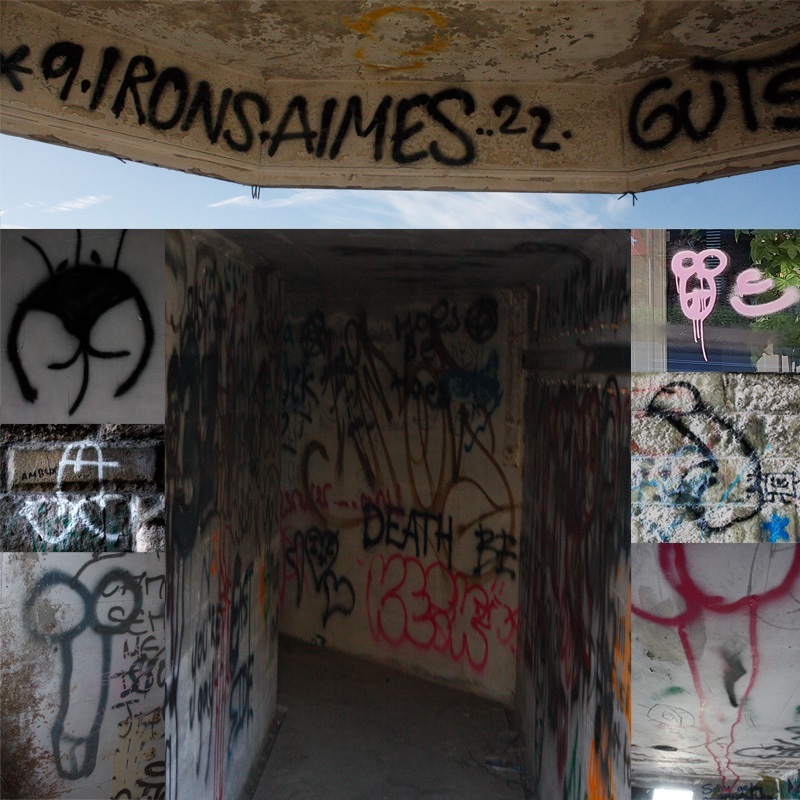Anatomy of a tag: a closer look at genitalia-centred graffiti
Arrow Koehler
24 June 2024, 12:19 AM
 An ill-proportioned attempt at graffiti of the male genitalia. Photo: Arrow Koehler
An ill-proportioned attempt at graffiti of the male genitalia. Photo: Arrow KoehlerThree semi-circles.
That is all it takes to scrawl a simple set of male genitalia.
A recent unfortunate incident involving a penis etched into a woman’s car windscreen raised the question around the office: "What is the obsession with phallic graffiti?"
So we asked some experts.
Local artist Matthew Wicks, aka Wicksey, suggests a penis and testicles are easy to draw, something you would draw as a child, and can be found in any boy’s (older than about eight) school book .
“Funnily enough, phallic symbols are some of the earliest forms of painting, going back hundreds of thousands of years, since the dawn of man,” he says.
“So maybe it's deeply rooted in our psyche that we want to draw willies on walls.”
Wicksey does not have to resist the urge to draw penises on walls.
“Have I drawn willies in the past? Yes, I think I still do. I think if I go past a mate's car and there's a dirty screen on the back, I'll draw a willy on the back of his car.
“But never in a place of hate.
“You’ve just got to be mindful of where you're doing it and when, and who's gonna be seeing it. But no, I don't make a habit of drawing penises on walls.”
Wicksey does not think phallic images are hateful, “just silly”.
He began his street art in the United Kingdom, where he did a painting of a boat at the pub he was working at.
He really liked working at a larger scale and continued creating murals when he returned to Ōamaru, but he finds people struggle to understand the difference between street art and graffiti.
“They instantly think of graffiti - negative messages and horrible things sprayed hurriedly on a wall - and we - me and other artists in the area - have worked really hard to say ‘no, it's not that’.”
Wicksey says vandalism and graffiti can have a negative impact on people.
“It's great that people want to express their creativity, but I think if it's done in a way that's distasteful, hurtful, or vandalism, that's just bad. It's not cool, because it's going to affect someone physically, mentally.
“Someone has to clean it up, basically. What you're doing is not wanted, and it's going to affect someone else's life in a negative way.”
He suspects many people use graffiti as a way to “yell something”.
Wicksey had a mural he had collaborated on with other artists graffitied, but did not feel that was from a place of hostility.
“I don't think that came from a place of hate. I think they were just a bit confused and did a silly thing and definitely regretted it.”
Many towns and cities have street art, and the art is not often graffitied over, however many people will “tag” over top of each other, he says.
He suspects there is “a sort of respect” for the artworks.
A “big creative space in town” which is regulated and policed, could be a way for people to practise their skills, without doing it illegally, he says.
Wicksey suspects people carrying out graffiti are “not in a great headspace” and do not think about the consequences.
However, he thinks the most hateful words are no longer written on physical walls, but on Facebook walls.

A montage of graffiti from around Ōamaru, including at Cape Wanbrow, under the Thames St bridge, and on store fronts. Photos: Arrow Koehler
Ōamaru Police Constable Jay Morriss agrees with Wicksey's theory, that penises are one of the simplest things to draw.
They are quick, recognisable, appeal to “simplistic humour” and get high shock value for minimal effort.
Jay says the most common graffiti in Ōamaru is tagging - people “making their mark”.
“For the 10 years I've been here, we've been fairly lucky,” he says.
However, there have been some higher profile graffiti cases in Ōamaru, including a “305 Otara” tag in the Garden of Memories in 2019 and a 1080 protest message on the Ōamaru sign in 2018.
He says the appendage scratched into the car windscreen is “the worst” he has seen.
“Just in terms of, you know, they've gone to the extent of actually scratching in a window. She had to replace the window.”
Jay says graffiti is most common “anywhere they won’t get caught”, including places with low lighting, minimal foot traffic, alleyways or in the dark. But graffiti in more public places is treated as a “badge of honour”.
Scratching things into windows, spray painting and using marker pens are common for tagging.
Another common vandalism in Ōamaru is damaging public toilets - lighting things on fire inside cubicles, covering them in toilet paper and ripping the fixtures of the walls.
It is mostly kids doing it, he says.
“Where youth tend to congregate sees more than its fair share.
“It's the sort of thing most people grow out of.”
Graffiti can also be subjective and some people may take greater offence than others.
Carving names into limestone buildings, spraying weed killer into someone else's grass and doing donuts in public parks is all wilful damage.
“The reality is it costs. It's a cost to someone.”
Graffiti has its own charges, under the umbrella of wilful damage - which covers breaking things and causing damage with intent.
For anyone considering graffiti, Jay suggests getting a whiteboard, trying out calligraphy or finding another creative outlet.
He believes Ōamaru’s worst graffiti is done by those in cars - “boy racers and bogans leaving tyre marks”.
It is dangerous to do and costly to remove.
He suggests people interested in showing off their cars can attend drag races, where they can be with like-minded car enthusiasts.




